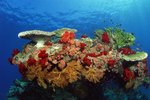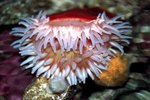
Throughout the world’s oceans, in both shallow and deep waters, more than 1,000 species of sea anemone make their homes. The largest and most diverse varieties of these animals are found in tropical waters. They come in almost any combination of colors, and can grow to be as large as six feet across, or as small as half an inch.
Appearance
Because they look so much like colorful, wide-blossoming plants, sea anemones are named after a kind of terrestrial flower. However, these creatures are actually invertebrate animals -- cousins of coral and jellyfish -- with hollow, cylindrical bodies that sit on a sticky disc or "foot." At their tops, they each carry a central mouth surrounded by tightly clustered tentacles resembling feather boas.
Mobility
While many prefer to stay fixed in one place, some anemones choose to move from one point to another. Some slowly creep along surfaces using the suction of their feet, as slugs would do on land. Other anemones tumble or somersault. And others, still, simply let go of whatever surface to which they cling and allow themselves to float away or "swim" by gently squirming through the water.
Offense and Defense
Anemones use the colorful, almost iridescent tentacles that surround their mouths to fire harpoon-like filaments, injecting a paralyzing neurotoxin into their prey. Their food is then guided into their mouths by their tentacles. The same toxic fire power is used when an anemone feels threatened. This can happen if the animal receives even the slightest touch. If a sting isn't enough to fend off the threat, anemones can pull their tentacles into their bodies and hide within their own hollows.
Symbiotic Relationships
Like their coral cousins, anemones establish important symbiotic relationships with other marine organisms. For example, anemones provide green algae sunny, safe places to live, and, in return, receive oxygen and sugar, which are byproducts of the algae's photosynthesis. Clownfish, which carry a layer of mucus on their skin that protects them from the anemone's stingers, live among the animal's tentacles. There, they are safe from predators, and the anemone can consume leftover scraps from the fish's meals.
References
Resources
Photo Credits
-
Jupiterimages/Photos.com/Getty Images
Writer Bio
Ruth Nix began her career teaching a variety of writing classes at the University of Florida. She also worked as a columnist and editorial fellow for "Esquire" magazine. In 2012, Nix was featured in the annual "Best New Poets" anthology and received the Calvin A. VanderWerf Award for excellence in teaching from the University of Florida.




